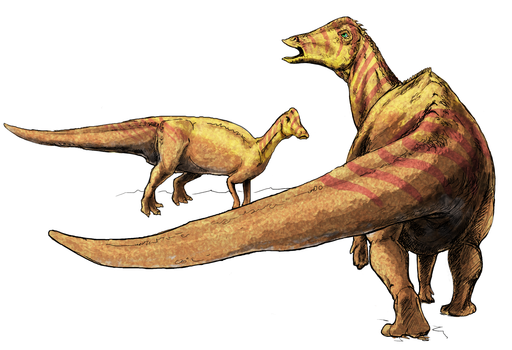FOR AGES 3 YEARS TO 18 YEARS
Bagaraatan, meaning 'small hunter' was a carnivorous dinosaur belonging to the genus Theropoda that lived during the Late Cretaceous period, roughly 71-83 million years ago. However, Mark Loewen et al. defined it as a basic tyrannosauroid based on Holtz's classification. The fossils of Bagaraatans were found in the Nemegt Formation of Mongolia. The postcranial skeleton that was found was matched with birds, but the skull displayed features of numerous theropod groups.
You can pronounce the name as 'Ba-ga-raa-tan'.
Bagaraatan was a carnivorous dinosaur from the Late Cretaceous era that belonged to the genus Theropoda.
Bagaraatan ostromi roamed the Earth roughly between 71-83 million years ago.
It is not known when Bagaraatan became extinct, but it lived during the Late Cretaceous era.
The fossils of Bagaraatans were found in the Nemegt Formation of Mongolia.
They were terrestrial creatures.
Due to a lack of data, we do not know the social structure of this theropod dinosaur.
Bagaraatan ostromi lived during the Late cretaceous period, roughly 71-83 million years ago.
These dinosaurs probably reproduced by laying eggs.
The postcranial skeleton was matched with birds, but the skull displayed features of numerous theropod groups. Its caudal vertebrae are firmly united and therefore limit horizontal and vertical movement making the tail extremely inflexible but muscular. The head and hindlimb of this theropod dinosaur are relatively slim in comparison to its whole body size.

Paleontologists are yet to figure out the number of bones this species had due to lack of data, but fossils of its Caudal vertebrae, pelvis, remains of its left mandible, tibia, pedal phalanges, fibula, and femur has been discovered.
Paleontologists assume that it used audible and visual signals like all other dinosaurs for communication.
Bagaraatan ostromi evolved to be 9.8-13 ft (3-4 m) in length. However, they were much smaller than the T-Rex!
Bagaraatan ostromi was an agile, rapidly moving predator with long legs.
We do not know the weight of a Bagaraatan due to a lack of data from the fossil found.
The male and female Bagaraatans do not have any specific names.
A baby dinosaur of any type is known as a nestling or hatchlings.
Bagaraatan means 'small hunter,' and since this dinosaur was a carnivore, it is presumed that it was highly aggressive.
In honor of Dr. John H. Ostrom, from Mongolian word 'baga', which means 'small', and 'araatan', which means 'predator'.
*We've been unable to source an image of Bagaraatan and have used an image of Zalmoxes instead. If you are able to provide us with a royalty-free image of Bagaraatan, we would be happy to credit you. Please contact us at [email protected]
*We've been unable to source an image of Bagaraatan and have used an image of Nipponosaurus instead. If you are able to provide us with a royalty-free image of Bagaraatan, we would be happy to credit you. Please contact us at [email protected]
Read The Disclaimer
At Kidadl we pride ourselves on offering families original ideas to make the most of time spent together at home or out and about, wherever you are in the world. We strive to recommend the very best things that are suggested by our community and are things we would do ourselves - our aim is to be the trusted friend to parents.
We try our very best, but cannot guarantee perfection. We will always aim to give you accurate information at the date of publication - however, information does change, so it’s important you do your own research, double-check and make the decision that is right for your family.
Kidadl provides inspiration to entertain and educate your children. We recognise that not all activities and ideas are appropriate and suitable for all children and families or in all circumstances. Our recommended activities are based on age but these are a guide. We recommend that these ideas are used as inspiration, that ideas are undertaken with appropriate adult supervision, and that each adult uses their own discretion and knowledge of their children to consider the safety and suitability.
Kidadl cannot accept liability for the execution of these ideas, and parental supervision is advised at all times, as safety is paramount. Anyone using the information provided by Kidadl does so at their own risk and we can not accept liability if things go wrong.
Kidadl is independent and to make our service free to you the reader we are supported by advertising.
We hope you love our recommendations for products and services! What we suggest is selected independently by the Kidadl team. If you purchase using the buy now button we may earn a small commission. This does not influence our choices. Please note: prices are correct and items are available at the time the article was published.
Kidadl has a number of affiliate partners that we work with including Amazon. Please note that Kidadl is a participant in the Amazon Services LLC Associates Program, an affiliate advertising program designed to provide a means for sites to earn advertising fees by advertising and linking to amazon.
We also link to other websites, but are not responsible for their content.
Was this article helpful?



We’ll send you tons of inspiration to help you find a hidden gem in your local area or plan a big day out.



Check your inbox for your latest news from us. You have subscribed to:
Remember that you can always manage your preferences or unsubscribe through the link at the foot of each newsletter.